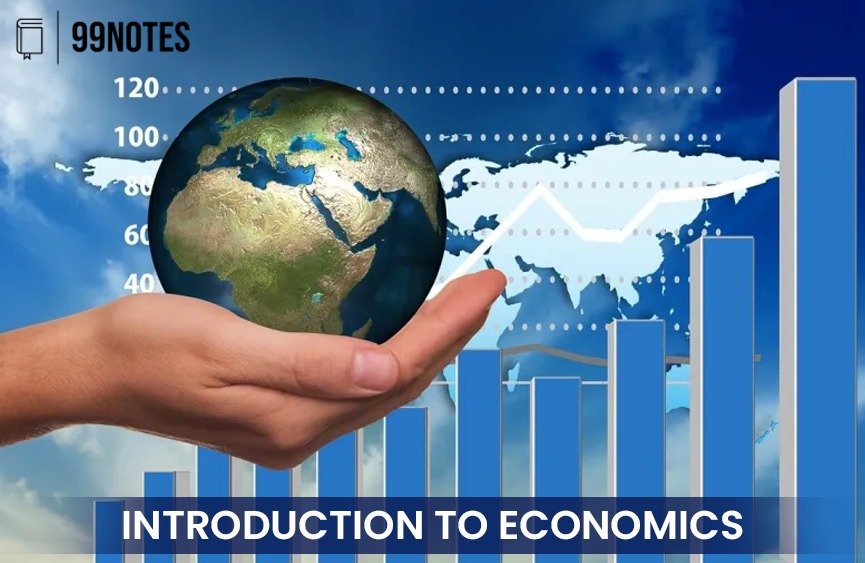Introduction to Economics UPSC Notes
Economics is the social science that focuses on the production, distribution and consumption of goods and services.
What is an Economic activity?
- What is an Economic activity?
- Types of economic activities:
- Economic activities have two parts:
- Measurement of economic activity
- Exchanges in the Market:
- Factors of production:
- Example:
- Demand and supply
- Demand curve:
- Supply curve:
- Basic assumptions of Economics:
- Concept of Marginal Utility:
- Law of Diminishing Marginal Utility
- Law of Diminishing Marginal Returns
- Marginal Revenue (MR) of Production:
- Marginal Cost of Production:
- The elasticity of demand and supply
- Price elasticity of demand:
- Price elasticity of Supply:
- Economy system
- Types of economic system
- Classical Approach:
- Keynesian Economics:
All activities involving money are called economic activities. It is any activity that contributes to that economy. Economic activity occurs when resources such as capital, labour, manufacturing techniques or intermediary products are combined to produce specific goods and services.
Thus, economic activity is characterized by an input of resources, a production process and an output of products (goods and services).
On the national level, economic activity can be defined as the collection of activities like production, distribution, consumption and exchange of goods and services contemplated to build a country’s wealth through whatever means are available.
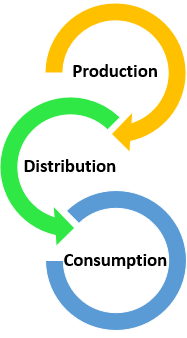
Types of economic activities:
The essential purpose of economic activity is to meet the needs of citizens. Within an economy, there are five types of economic activity. These are;
- Primary economic activity: It usually involves raw materials (mainly collecting them); this includes logging, mining, and farming.
- Secondary economic activity: It is usually the next step in production following the collection of raw materials. This often results in manufacturing something from those materials, such as paper from wood or pulp or refining ore into metal.
- Tertiary economic activity: It involves services to people. Tourism, banking, transport, and commerce are examples of tertiary activities.
- Quaternary economic activity: it is intellectually based; it involves creating, maintaining, developing or communicating information. This includes research and development companies and many information-related activities like internet technology or computer engineering.
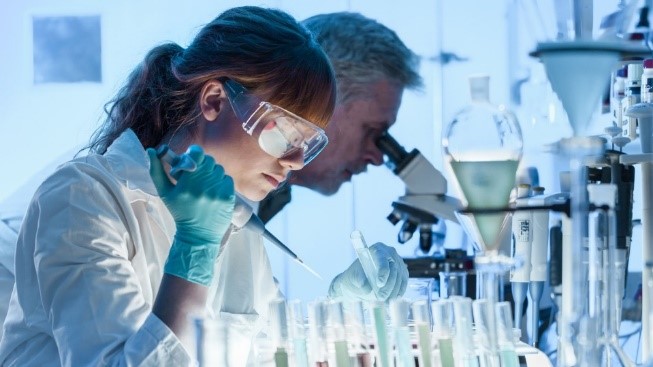
- Quinary economic activity: It is a kind of ‘gold collar’ profession. This includes Business executives, government officials, research scientists, financial and legal consultants.
Economic activities have two parts:
- Market activities:
- It involves remuneration to anyone who performs their work;
- Action performed for pay or profit.
- Ex: goods or services, including government services.
2. Non-market activities:
- It involves production for self-consumption.
- Consumption and processing of Primary products,
- Activity performed for Own account production of fixed assets.
- For a company: Non-market productive activities. Ex: Human resource management.
Measurement of economic activity
How do you know if your country’s economy is doing well? GDP (gross domestic product) is one of the elementary indicators used to measure a country’s economic activity worldwide.
It represents the total values of all goods and services produced in a country each year and is often used when referring to the size of a country’s economy. When the economy is healthy and growing, you will typically see steady increases in a country’s GDP; if it falls, the economy contracts. We shall study it in chapter 2 in detail.
Exchanges in the Market:
- Voluntary Exchange: Seller values the money more than his product, and buyer values the product more than his money. It is the same for the services.
- Involuntary Exchange: Resource allocation activities imposed on the economy by government taxes, laws and regulations. The participant wouldn’t have taken those exchanges had he not been coerced.
Factors of production:
The population of the economy is derived from its workforce, people who contribute to production. There may fundamentally be four kinds of contributions during the production process:
- Human labour: Which is skilled in its job. Remuneration for labour is called the Wage
- Capital: It is the Input in the business. These can be of two kind
- Fixed Capital: Tools, Machines, buildings: Their value depreciates.
- Working Capital: Raw material & money in hand: Most important part.
Remuneration to working capital or simply capital is called Interest.
- Fixed natural resources (called ‘land’), remuneration for which is called Rent.
- Entrepreneurship or Human Capital: To be able to enterprise the above requirements.
- Remuneration of which is Profit
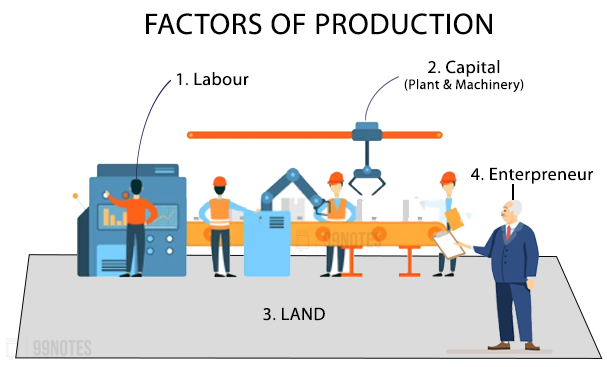
Example:
- Land- Any natural resources that come from land that can be common land or natural resources like water, oil, coal, forests, minerals etc. These are the raw materials in the production process. These resources can be renewable (land/water/forest) or non-renewable.
- Labour – It is an effort that humans contribute to producing goods and services. It includes work done by waiters, bonded farmers, carpenters, masons etc. If one is paid for a job, then he contributes to the production of goods and services as labour resources.
- Capital – Capital as money, machinery, tools, human (human capital) etc., used to produce goods and services.
- Entrepreneurship- he is someone who combines other factors of production (land, capital, labour) to earn a profit. A successful entrepreneur is one who brings new products new technology, or a new method of production of goods and services into the market. They are a vital engine of economic growth where they have the freedom to start a new business and use resources freely.
Demand and supply
Understanding Demand
Demand is the number of goods or services that a consumer intends to buy.
The law of demand states that there exists an inverse relationship between the price and quantity of demanded goods. We can say that as Higher the prices, the lower the demand.
Determinants of demand –
- Price of commodity
- Price of other related goods
Understanding Supply
Supply is the quantity of a commodity that a firm is willing and able to sell at a given price.
The law of supply states that by keeping other factors constant, if prices increase, the supply of goods also increases.
Supply and Demand graph:
It has 2 axes, the vertical axis represents the price of goods or services, while the horizontal represents the number of goods or services.
Demand curve:
- As price increases, the consumers reduce their consumption of the said commodity. When the Price is low, consumers buy such a product in larger quantities.
- Therefore, the demand curve is almost always downward sloping, reflecting the willingness of consumers to purchase more of the commodity at a lower price level.
Supply curve:
- As the supply and quantity increase, the price decreases and vice-versa.
- The supply curves slope upward from left to right, indicating that the producers are willing to supply more products as the price of goods and services increases.
- It reflects producers’ willingness to sell more of the commodity in a higher-priced market.
At equilibrium, it represents the price quantity point where the market stabilizes.
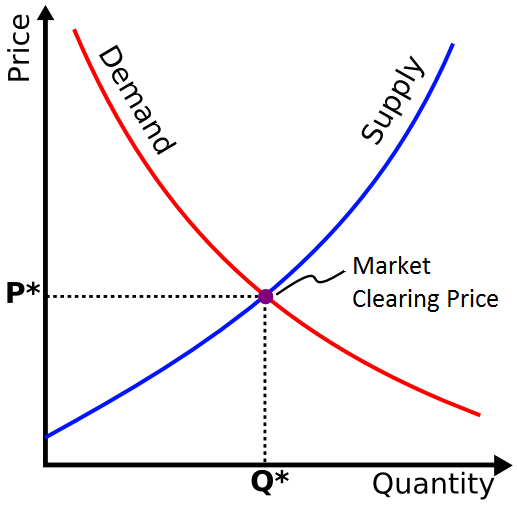
Basic assumptions of Economics:
- Scarcity: People have unlimited wants and finite resources.
- Self-Interest: Everyone tries to maximise satisfaction. Everything has a cost; thus, economic actors make all decisions after a cost-benefit analysis.
Concept of Marginal Utility:
Economists use this concept to understand how much of an item consumers intend to purchase.
Marginal utility is the consumer’s pleasure from each extra consumption degree. It calculates the utility beyond the first product consumed. For example, if you buy a packet of biscuits and then a 2nd one, the utility gained from the second packet of biscuits is the marginal utility.
The marginal utility can be positive, zero, or negative.
- Negative marginal utility takes place when the consumption of one more unit decreases the overall utility. This is generally what we see for most products in the economy.
- Positive marginal utility means when the consumption of an additional item increases the total utility. Such a case occurs usually for addictive articles.
Law of Diminishing Marginal Utility
- As the aptness of a product reduces as its consumption increases, consumers are willing to pay smaller amounts.
- For example: When you are very hungry, the utility of a pack of biscuits is very high. However, when you have eaten 2-3 packs of it, and you are full, the utility of that same pack utility decreases.
Law of Diminishing Marginal Returns
- It states that adding an additional factor of production results in smaller increases in output.
- It predicts that after some optimal level is reached, further adding an additional factor of production will result in smaller or no increases in output.
- For example, a factory employs workers to manufacture its products, keeping all other factors constant; if the management adds workers beyond this optimal level will result in less efficient operations.
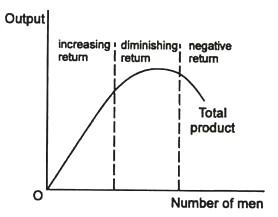
Marginal Revenue (MR) of Production:
- The rise in income comes from the sale of one additional output unit.
- While MR can remain constant over a certain output, it follows from the law of diminishing returns that revenue will eventually slow down as the output level increases.
- In economic theory, perfectly competitive firms continue producing output until marginal revenue equals marginal cost.
Marginal Cost of Production:
The variation in total production cost occurs by producing one additional unit.

The purpose of analysing marginal cost is to determine at what point an organisation can achieve economies of scale to optimise production and overall operations.
The elasticity of demand and supply
- Elasticity: It is the measurement of change in the number of goods in relation to the change in prices.
- Elastic and inelastic demand: If there is a change in volume demanded with the change in prices, it is called elastic demand. If the quantity of demand for a good doesn’t change much with the change in its price, then the good is considered inelastic.
- Zero price elasticity of demand: whatever the change in price, there is no change in demand.
Price elasticity of demand:
It is the ratio of the percentage change in volume demanded to the percentage change in prices. It is expressed mathematically,

- It can also be called Price sensitivity.
- Perfectly Elastic Demand (∞): A Small change in price means a large change in demand; For example, Gold. If the price is increased even by 5%, People stop buying it.
- Perfectly Inelastic Demand (0): Demand is not affected by price. People buy this article no matter what the price. For example, Onions, Potato, Tomato etc. No matter what the price, people eat food.
- Relatively Elastic Demand (> 1), Relatively Inelastic Demand (< 1), Unitary Elasticity Demand (= 1).
- Negative price elasticity: Demand increases with the price increase. For example, luxury Items sometimes show this behaviour.
Price elasticity of Supply:
It is the degree to which the effective supply of something changes as its price changes.

- Perfect elasticity: Everyone starts supplying this product when the price of the product goes up, even by a small amount in the market. For example, Hand Sanitizer during Corona.
- Perfect Inelasticity: When the price becomes high, supply doesn’t change; For example, food items, such as Onions, Technology products etc.
Considering the scarcity of resources, we need a correct choice of economic activity to ensure the optimum use of resources. The resources should be put to their maximum benefit. The optimum is the most incredible satisfaction level and considers the sustainable development approach.
Economy system
After the great depression (during the 1930s) the domain of economics was divided into two broad branches – the Micro and Macro economies. John Maynard is considered the father of macroeconomics (the branch came into being after the publication of his seminal work, The General Theory of employment, interest and the money, in 1936.
While the Micro takes a bottom-up approach to analyse the economy, the Macro takes a top-down approach.
While Micro tries to understand consumers’ choices and income, Macro tries to understand inflation and growth dynamics. Though they appear different, they are interdependent and complementary since they have many overlapping issues. For example, a rise in inflation (macro effect) will cause an increase in the cost of raw materials leading to rising prices that consumers will pay (micro effect).
We mainly focus on macroeconomics as it involves studying a nation and its economic issues involving employment, inflation, interest rates, Trade, its effect on the country when in deficit/ surplus, fiscal deficits etc.
Types of economic system
- Classical /Traditional Approach by Adam Smith
- Keynesian Economics by John Maynard Keynes
- Neo-classical Approach by the likes of Milton Friedman.
Classical Approach:
- In the 1740s, Adam Smith, the founding father of modern economics (wrote: An Inquiry into the Nature and Causes of the Wealth of Nations (1776)), was a follower of the Libertarian tradition.
- He suggested that if the buyers and sellers in each market follow their self-interest, economists will not need to think of the wealth and welfare of the country as a whole separately. Instead, an equilibrium would occur automatically between supply and demand (the market’s invisible hand).
- He laid the foundation of the classical free market.
- He studied social philosophy and collaborated with Hume.
- According to him, Demand and supply explain the price of Goods and services in an economy. He also gave a new concept of division of labour.
Drawbacks
- In Some cases, the market couldn’t exist, especially In Remote areas where there are only a few buyers & sellers. If sudden demand rises in this situation, they fail to produce an equilibrium between demand and supply.
- In many situations, society had decided to pursue certain important social goals unselfishly, for which some of the aggregate effects of microeconomic decisions made by the individual economic agents needed to be modified.
- According to the assumption by the Classical tradition, all the labourers willing to find employment will get work, and all factories will be working at their full capacity. But after The Great Depression, the thought broke; Even in the US unemployment rate rose from 3% to 25%, and factory output fell by 33%.
- A free market for organ donations and surrogacy sometimes seems unethical. Regulation can provide a good solution for such cases.
Keynesian Economics:
- Keynesian Economics gives birth to the Macroeconomics concept.
- British economist John Maynard Keynes published his celebrated book The General Theory of Employment, Interest and Money (1936). He refined the theory of causes of business cycles.
- John Maynard Keynes Challenges the ideas of neoclassical economics.
- He argued that aggregate demand discerned the overall level of economic activity and that superfluous aggregate demand could be directed to prolonged periods of high unemployment.
- According to him, the state’s intervention was necessary to moderate “boom and bust” cycles of economic activity(cycles of inflation and deflation).

- Keynes advocated the use of various monetary and fiscal policies to mitigate the adverse effects of economic recessions and depressions.
- Possible Adverse Effects of Recessions: Low Production, low employment & high prices.
- Technically: Low GDP, high unemployment rate and high inflation.
- Market equilibrium takes time to achieve, and “in the long term, we all are dead“. However, we can’t wait long because economic instabilities lead to political instabilities.
Criticism:
- Milton Friedman highly criticised Keynesian Economics. He disputed the ability of the government to regulate the business cycle favourably with fiscal policy.
- Friedman argued that the “naïve Keynesian” Idea failed during an extended period of inflation or stagflation. Thus, he again supported the idea of limited state intervention in the economy. This approach is known as the Neo-classical approach.
Significance:
- World Bank & IMF were based on these thoughts.
- After the 2007-08 Financial crisis, there was a worldwide resurgence in the Keynesian view.
- Many even think that the radical idea that the government should spend even in a capitalist system might have saved Capitalism.
Our next topic of discussion will be about the growth and development economy focussing mainly on the Indian economy.

